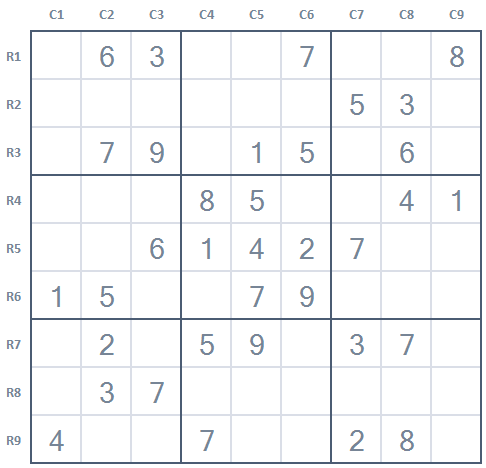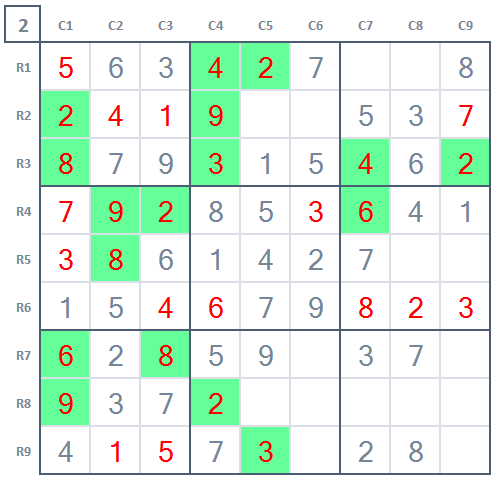
Solve and learn to solve easy Sudoku game 6
The Sudoku for beginners game 6 is solved using most basic Sudoku technique of row column scan and each step explained. First solve and then learn to solve.
In this sixth session, with brief recap on Sudoku basics, we will directly take up step by step solution of the Sudoku game that was the exercise in the last session.
To know the basics of Sudoku in more details please go through the solution of Sudoku for beginners 1 or Sudoku for beginners 2.
If you want to skip the brief recap on Sudoku basics and go straight to the solution of game 6, click here.
Brief recap on Sudoku basics
The following is the beginner Sudoku game we would solve in this session.

The 81 cell game above is a specific Sudoku game with some cells filled up with digits from 1 to 9. These are the valid digits that you can use to fill up any empty cell.
While filling up any empty cell you must follow the Sudoku game rule:
You must not repeat any digit in any column, in any row or in any 9-cell medium sized square bordered by thick lines.
The whole board has 9 such 9-cell squares with thick borders.
Ultimately your job is to fill up all the empty cells with digits 1 to 9 but without breaking the Sudoku game rule not even once. Then only we would say you have successfully completed the game.
For convenience, we will use the labels C1, C2, C3......C9 for identifying the 9 columns and labels R1, R2, R3....R9 for 9 rows.
We will refer to a cell by its row label suffixed with column label. For example top left corner cell is R1C1 and bottom right corner cell is R9C9.
Each of the 9-cell groups we will call a 9-cell square or a major square.
The nine major squares are identified as top left, top middle, top right, left middle, central middle, right middle, bottom left, bottom middle and lastly bottom right.
A row, a column or a major square each has 9 cells and broadly referred to as a Zone.
Primary objective at each step
The only objective at each step is to find a cell in which one and only one digit can be placed. This is what we call a valid cell.
Valid cell and Valid digit
We would repeat the definition of valid digit and the valid cell.
We define a VALID digit as the digit you put in an empty cell so that,
It is the only possible digit which you can put in the cell following the rules of the game.
As before, the most important objective is, how to find out the cell in which you can put one and only one digit out of the digits 1 to 9.
We have used the most basic technique of row column scan or horizontal-vertical cross-scanning.
We have used the concept of a favorable zone as a column or a row or a 9-cell square with high digit occupancy so the number of digits possible to fill up the empty cells in the zone is much less and so by eliminating the few other contenders getting only a single digit for a single cell is that much higher.
We also have used digits with high occurrence in the board, that is, the favorable digits to our advantage.
For a favorable digit that has appeared, say, in 7 cells out of maximum 9 possible all over the board, finding the rest of the two valid cells for this favorable digit by row-column scan is generally very easy because of elimination of a large part of the board by its occurrence in most zones.
Solution to the Sudoku for beginners game 6 Stage 1: Let's find the first few valid cells
For convenience let's show again the game we are going to solve.

We define a new row column scan strategy.
With a brief scan, identify the digit that appears maximum number times. This is the most promising digit and we'll first scan for it.
Offhand it seems 7 appears maximum 7 times. We decide to scan for 7: first success: R2C9 7 by scan R1, R3 -- R4C1 7 by scan in R5, C2, C3.
Neighborhood scan success: R6C3 4 by scan R4, R5 -- continuing with 4, R2C2 4 by scan C1, C3 -- neighborhood scan R1C1 5 by scan R2, R3 -- continuing with 5 R9C3 5 by scan R7, C1, C2.
Opportunistic valid cell R6C7 8 by scan R4, C8, C9.
Digit 8 and digit 9 no more success we go back to scanning for digit 1: R2C3 1 by scanning in R3, C1 - continuing with 1, R9C2 1 by scan in C1, C3.
An opportunistic neighborhood valid cell R5C1 3 by scan C2, C3.
Followed by R6C9 3 by scan R5, C7, C8 -- R4C6 3 by scan in R6 -- R6C4 6 by exception in central middle major square -- R6C8 2 by exception in R6.
Following is the game status at this point.

Solution to the Sudoku for beginners game 6 Second stage
First come first served hit R3C9 2 by scan C7, C8 -- R2C1 2 by scan R3 -- R4C3 2 by scan C1, C2 -- R3C1 8 by exception in top left major square.
R5C2 8 by scan R4 -- R4C2 9 by exception in both C2 and left middle major square -- R4C7 6 by exception in R4.
An intuitive valid cell hit: R9C5 3 by scan R8, C6. Explored which digit eliminates all three empty cell of major square and creating scope for a hit in most sparsely filled major square? 3 in R8 supplied the clue.
Continuing with 3: R3C4 3 by scan in R1, R2. Digit 3 over.
R3C7 4 by exception in R3. R1C4 4by scan R2, C5. 4 in R2 is located first with an objective to identify the digit in R2 that'll eliminate all three empty cells of the top middle major square in R2.
By the same technique, R1C5 2 by scan in R2.
Now we scan 2 in C5, C6 to get R8C4 2, the last 2.
R2C4 9 by exception in C4. R7C3 8 by exception in C3. R8C1 9 by scan in R7.
R7C1 6 by exception in bottom left major square.
Game status at this stage is shown below.

Solution to the Sudoku for beginners game 6 Third and final stage
Quick hit R5C9 8 by scan in C8. Among the very favorable zones with only 2 missing digits, R7 produces positive result: missing digits [1,4] -- R7C6 1 by scan in C9 -- R7C9 4 by exception in R7.
Similarly in the next very favorable zone R9 with missing digits [6,9], R9C9 9 by scan C6 on two empty cells of R9 -- R9C6 6 by exception in R9.
This creates R2C5 6 by scan in C6 -- R2C6 8 by exception in top middle major square -- R8C5 8 by scan in C6 -- R8C6 4 by exception in bottom middle major square.
An immediate scan opportunity: R5C8 9 by scan in C9 -- R5C9 5 -- R8C9 6 by exception in C9.
R1C7 9 by scan C8 -- R1C8 1 by exception in R1 -- R8C8 5 by exception in C8 -- R8C7 1 by exception in R8, C7 and the bottom right major square.
Final solution shown below.

We'll now leave you a new game to solve as exercise. You may look up its solution in the seventh session (link below) beginner Sudoku game play.
A game for you to solve
We leave you here with a new game for you to solve. In our next session we will present its solution and another new game.
Enjoy.

Sudoku for beginners learning and practice sessions
Sudoku for beginners 11 - Learn and practice Sudoku level 1
Sudoku for beginners 10 - Learn and practice Sudoku level 1
Sudoku for beginners 9 - Learn and practice Sudoku level 1
Sudoku for beginners 8 - Learn and practice Sudoku level 1
Sudoku for beginners 7 - Learn and practice Sudoku level 1
Sudoku for beginners 6 - Learn and practice Sudoku level 1
Sudoku for beginners 5 - Learn and practice Sudoku level 1
Sudoku for beginners 4 - Learn and practice Sudoku level 1
Sudoku for beginners 3 - Learn and practice Sudoku level 1
Sudoku for beginners 2 - Learn and practice Sudoku level 1
Learn to Play Sudoku for Beginners Game 1
Second and higher level Sudoku games
You will get links to all the 2nd level Sudoku game solutions at Second level Sudoku.
Links to third and higher level Sudoku game solutions are available in the main Sudoku page.
It is recommended that without jumping over any of the hardness levels, one should progress through solving higher level Sudoku games strictly step by one step up. For example, you shouldn't play a 3rd level Sudoku game without being comfortable in solving 2nd level games.